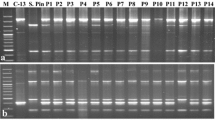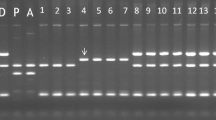Abstract
Thirty-eight Indian potato varieties and fifty-two advanced hybrid lines were analyzed for cytoplasm types using both plastid and mitochondrial genome specific markers. Indian genotypes thus analysed could be broadly grouped into 4 cytoplasm types i.e. T/β (69), W/α (18), W/γ (1) and A/ɛ (2). The T/β type cytoplasm, typical of common cultivated potato (ssp. tuberosum) was absent in six released varieties (Kufri Chipsona-1/-2/-3 series, Kufri Jawahar, Kufri Megha and Kufri Himalini) and fifteen out of fifty two hybrids analyzed. This information was further used to predict cytoplasm type on the basis of common shared maternal pedigree in thirty-eight other advanced hybrids, which revealed majority (25) had T/β type cytoplasm with W/α and A/ɛ cytoplasm observed in 12 and 1 genotype, respectively. T/β type cytoplasm was observed in all 28 early bulking hybrids studied along with all old genotypes. It was revealed that considerable broadening of maternal base was observed in recently developed genotypes. W/α type cytoplasm was present in most of processing (all 3 chipping varieties and 9 of 12 MP hybrids) and late blight resistant (11of 23 hybrids) genotypes.
Similar content being viewed by others
Abbreviations
- cp-type:
-
Plastid genome type
- T:
-
tuberosum type
- A:
-
andigena type
- GM:
-
Maternal grandmother
- cpDNA:
-
Plastid DNA
- mt-type:
-
Mitochondrial genome type
- W:
-
Wild type
- cpSSR:
-
Chloroplast simple sequence repeats
- GGM:
-
Matrilineal great grandmother
- mtDNA:
-
Mitochondrial DNA
References
Amoah V, Grun P, Hill JR (1988) Cytoplasmic substitution in Solanum I. Tuber characteristics of reciprocal backross progeny. Potato Res 31:121–127
Bryan GJ, McNicoll J, Meyer RC, Ramsay G, De Jong WS (1999) Polymorphic simple sequence repeat markers in chloroplast genomes of Solaneceaous plants. Theor Appl Genet 99:859–867
Chimote VP, Chakrabarti SK, Pattanayak D, Naik PS (2004) Semi-automated simple sequence repeat analysis reveals narrow genetic base in Indian potato cultivars. Biol Plant 48:517–522
Doyle JJ, Doyle JL (1987) A rapid DNA isolation procedure for small quantities of fresh leaf tissue. Phytochem Bull 19:11–15
Glendinning DR (1983) Potato introductions and breeding up to the early 20th century. New Phytol 94:479–505
Grun P (1990) The evolution of cultivated potatoes. Econ Bot 44(suppl 3):39–55
Grun P, Ochoa C, Capage D (1977) Evolution of cytoplasmic factors in tetraploid cultivated potatoes (Solanaceae) Amer J Bot 64:412–420
Hosaka K, Hanneman RE (1988) The origin of the cultivated tetraploid potato based on chloroplast DNA. Theor Appl Genet 68:55–61
Hosaka K (1993) Similar introduction and incorporation of chloroplast DNA in Japan and Europe. Jpn J Genet 90:356–363
Hosaka K (1995) Successive domestication and evolution of Andean potatoes as revealed by chloroplast DNA restriction endonuclease analysis. Theor Appl Genet 90:356–363
Hosaka K (2003) T-type chloroplast DNA in Solanum tuberosum L. ssp. tuberosum was conferred from some populations of Solanum tarijense Hawkes. Amer J Potato Res 80:21–32
Jansen G, Flamme W, Schuller K, Vandarey M (2001) Tuber and starch quality of wild and cultivated potato species and cultivars. Potato Res 44:137–146
Lossl A, Gotz M, Braun A, Wenzel G (2000) Molecular markers for potato cytoplasm: male sterility and contribution of different plastid-mitochondrial configurations to starch production. Euphytica 116:221–230
Lossl A, Adler N, Horn R, Frei U, Wenzel G (1999) Mitochondrial genome type characterization of potato: Mt α, β, γ, δ and ɛ and novel plastid-mitochondrial configurations. Theor Appl Genet 99:1–10
Maris B (1989) Analyses of an incomplete diallel cross among three ssp tuberosum varieties and seven long-day adapted ssp. andigena clones of potato (Solanum tuberosum L.). Euphytica 41:163–182
Mendoza HA, Haynes FL (1974) Genetic relationship among potato cultivars grown in United States. HortScience 9:328–330
Powell W, Baird E, Duncan N, Waugh R (1993) Chloroplast DNA variability in old and recently introduced potato cultivars. Ann Appl Bot 123:403–410
Provan J, Powell W, Dewar H, Bryan G, Machray GC, Waugh R (1999) An extreme cytoplasmic bottleneck in the modern European potato (Solanum tuberosum) is not reflected in decreased levels of nuclear diversity. Proc R Soc Ser B 266:633–639
Rasmussen JO, Lossl A, Rasmussen OS (2000) Analysis of the plastid genome and mitochondrial genome origin in plants regenerated after asymmetric Solanum ssp. protoplast fusions. Theor Appl Genet 101:336–343
Sinha SK, Pushkarnath (1964) The relationship of Indian potato varieties to Solanum tuberosum subsp. andigena. Indian Potato J 6:24–39
Spooner DM, Nunez J, Rodriguez F, Naik PS, Ghislain M (2005) Nuclear and chloroplast DNA reassessment of the origin of Indian potato varieties and its implications for the origin of the early European potato. Theor Appl Genet 110:1020–1026
Sukhotu T, Kamijima O, Hosaka K (2004) Nuclear and chloroplast DNA differentiation in Andean potatoes. Genome 47(1):46–56
Sukhotu T, Kamijima O, Hosaka K (2006) Chloroplast DNA variation in the most primitive cultivated diploid potato species Solanum stenotomum Juz. et Buk. and its putative wild ancestral species using high-resolution markers. Genet Res Crop Evol 53(1):53–63
Swaminathan MS (1958) The origin of the early European potato- evidence from Indian potato varieties. Indian J Genet Plant Breed 18:8–15
Acknowledgment
The authors are grateful to Director, Central Potato Research Institute and Head, Crop Improvement for providing necessary facilities to undertake this study. Help rendered by Meetul Kumar, Naresh and Mr. C.M.S. Bist during this study is also gratefully acknowledged.
Author information
Authors and Affiliations
Corresponding author
Rights and permissions
About this article
Cite this article
Chimote, V.P., Chakrabarti, S.K., Pattanayak, D. et al. Molecular analysis of cytoplasm type in Indian potato varieties. Euphytica 162, 69–80 (2008). https://doi.org/10.1007/s10681-007-9563-7
Received:
Accepted:
Published:
Issue Date:
DOI: https://doi.org/10.1007/s10681-007-9563-7




